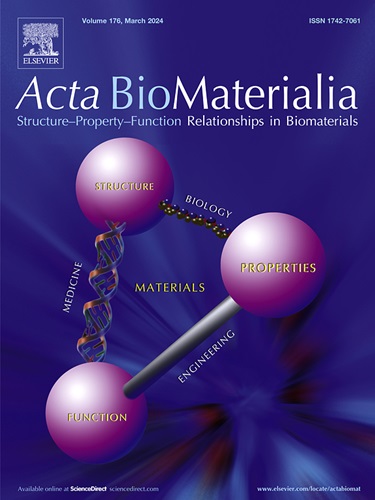Co-assembly of oligo-urethane nanoparticles with defined lipid additives to tailor RNA delivery into cells
IF 9.6
1区 医学
Q1 ENGINEERING, BIOMEDICAL
引用次数: 0
Abstract
Developing safe and effective biomaterials to deliver RNA into cells has grown in importance over recent years and has enabled the clinical translation of several gene therapies. Self-assembled oligo-urethane nanoparticles (PNPs) have several advantageous properties, such as (1) mitigating immune cell response in vivo, (2) low cytotoxicity in a broad range of cells, and (3) capable of delivering oligonucleotides or proteins into cells. Here, we were interested in defining unique configurations of PNPs to assess their relative cytotoxicity to human cells, comparing them to a popular commercial lipid system MessengerMax, as some cationic lipids have been found to have associated toxicity, instigating the search for less toxic counterparts. This was then followed by demonstrating the ability of enhanced green fluorescent protein (EGFP) mRNA to be loaded onto the PNPs, and to establish methods to enable the efficient transgene expression in a number of cell types, including Caco-2 and C2C12 cells which are known to be difficult-to-transfect cells. The addition of small amounts of PEGylated lipid to PNP significantly increased EGFP expression in HEK293T cells, Caco-2 cells and C2C12 cells at an effective mRNA/PNPs ratio (wt/wt) of 1:40, while the addition of the ionizable cationic lipid, significantly increased EGFP expression in C2C12 cells and differentiated C2C12 cells (myofibers) at mRNA/PNPs ratio (wt/wt) of 1:125, while keeping PNPs mass constant to 62.5 μg and changing the mRNA mass. Our study demonstrated that lipid-assisted, PNP-mediated mRNA delivery achieved a high transfection efficiency in terminally differentiated myofibers, paving the way for potential innovative therapeutics, e.g. targeted to muscular dystrophies.
Statement of significance
There are reports of diverse delivery agents for RNA, but there is still unmet need for more versatile, and safe delivery vehicles. In this study we demonstrated that when compared to MessengerMax (a lipid-based mRNA transfection reagent), self-assembled oligo-urethane nanoparticle (PNP) showed favorable cell viability. The scope of PNP as a RNA delivery vehicle was extended beyond HEK293T cells by showing transfections into a number of cell types. The addition of select lipids to PNPs, significantly increased EGFP expression in difficult-to-transfect cells: Caco-2 (2.9-fold), C2C12 (1.4-fold) and differentiated C2C12 (1.28-fold) cells when compared to PNPs. These findings indicate that select lipid incorporation on PNPs provide a promising strategy to improve the efficacy of RNA therapeutics for diseases in clinical applications.

低聚氨基甲酸乙酯纳米颗粒与确定的脂质添加剂的共组装,以定制RNA递送到细胞中。
近年来,开发安全有效的生物材料将RNA传递到细胞中变得越来越重要,并使几种基因疗法的临床翻译成为可能。自组装的低聚氨基甲酸乙酯纳米颗粒(PNPs)具有几个有利的特性,例如(1)在体内减轻免疫细胞反应,(2)在广泛的细胞中具有低细胞毒性,以及(3)能够将寡核苷酸或蛋白质递送到细胞中。在这里,我们感兴趣的是定义PNPs的独特结构来评估它们对人类细胞的相对细胞毒性,并将它们与流行的商业脂质系统MessengerMax进行比较,因为一些阳离子脂质已被发现具有相关的毒性,从而激发了对毒性较小的同类物的研究。随后,他们展示了增强的绿色荧光蛋白(EGFP) mRNA装载到PNPs上的能力,并建立了在多种细胞类型中高效表达转基因的方法,包括Caco-2和C2C12细胞,这些细胞已知是难以转染的细胞。在PNP中加入少量聚乙二醇化脂质后,HEK293T细胞、Caco-2细胞和C2C12细胞中EGFP的有效mRNA/PNPs比(wt/wt)为1:40,EGFP的表达显著增加;加入可电离阳离子脂质后,EGFP在C2C12细胞中表达显著增加,并分化为C2C12细胞(肌纤维),mRNA/PNPs比(wt/wt)为1:25,PNPs质量保持在62.5 μg, mRNA质量发生变化。我们的研究表明,脂质辅助、pnp介导的mRNA传递在终末分化肌纤维中实现了高转染效率,为潜在的创新治疗肌营养不良铺平了道路。重要性声明:有报道称RNA的递送剂多种多样,但对更通用、更安全的递送载体的需求仍未得到满足。在这项研究中,我们证明了与MessengerMax(一种基于脂质的mRNA转染试剂)相比,自组装的低聚氨基甲酸酯纳米颗粒(PNP)具有良好的细胞活力。通过转染到多种细胞类型,PNP作为RNA递送载体的范围已扩展到HEK293T细胞之外。与PNPs相比,在PNPs中添加精选脂质可显著提高EGFP在难以转染的细胞中的表达:Caco-2(2.9倍),C2C12(1.4倍)和分化的C2C12(1.28倍)细胞。这些发现表明,选择性脂质掺入PNPs为提高RNA治疗药物在临床应用中的疗效提供了一种有希望的策略。
本文章由计算机程序翻译,如有差异,请以英文原文为准。
求助全文
约1分钟内获得全文
求助全文
来源期刊

Acta Biomaterialia
工程技术-材料科学:生物材料
CiteScore
16.80
自引率
3.10%
发文量
776
审稿时长
30 days
期刊介绍:
Acta Biomaterialia is a monthly peer-reviewed scientific journal published by Elsevier. The journal was established in January 2005. The editor-in-chief is W.R. Wagner (University of Pittsburgh). The journal covers research in biomaterials science, including the interrelationship of biomaterial structure and function from macroscale to nanoscale. Topical coverage includes biomedical and biocompatible materials.
 求助内容:
求助内容: 应助结果提醒方式:
应助结果提醒方式:


